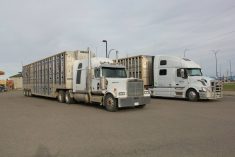EDMONTON – Take about 700 head of livestock, mix in hot, soapy water, cold air and warm air, toss in some stress and you have a recipe for sick cattle.
It’s also called a cattle show.
Veterinarian Roy Lewis said show officials and livestock producers can do plenty to prevent sickness from racing through show barns, but it’s impossible to prevent all illnesses.
“Respiratory disease is number one we worry about and the most serious,” said Lewis who was asked to look at more than a dozen animals by noon on Nov. 11, just part way through the week-long cattle show at Farmfair, which ran Nov. 5-14 in Edmonton.
Read Also

Petition launched over grazing lease controversy
Battle continues between the need for generation of tax revenue from irrigation and the preservation of native grasslands in southern Alberta rural municipality.
Lewis also sees stress diarrhea, lameness and lice.
“Sometimes show cattle are primed for the show but some prevention still gets missed,” said Lewis referring to lice showing up in show cattle.
“There is a myriad of things we see,” said Lewis.
Unlike commercial cattle, show cattle can’t be left with lumps or bumps from injection sites and alternative medication needs to be used.
Most cattle producers on the show circuit use preventive medicine and vaccinate cattle or give them a long acting antibiotic before coming to shows, he said.
“In fairness, all purebred breeders know when they come to a show there is always a risk.”
He said organizers also try and prevent breed intermingling as a way to limit the spread of viruses.
Each breed is also stalled together in smaller groups to limit disease spread.
For the first time this year, each breed was tied together in the night tie-out barns.
“Before it was willy, nilly, the Herefords beside the Angus beside the Speckled Park.”
A day earlier, Lewis spent the day with Agriculture Canada researcher Al Schaefer using a thermograph, or eye scanner, as an early indicator of sickness.
The scanner was able to confirm that animals owners identified as ill turned out to have a respiratory illness.
Lewis said the thermograph technology worked well on the tame show cattle, but may need to be improved before it can be used on less tame commercial cattle because of the length of time the scanner needs to be held to the eye.
What is thermography?
•Infrared thermography uses a fast infrared camera to record up to 60 images per second and can accurately measure radiated temperature
•Eye socket temperature rises about four days before an actual body temperature increase, which provides advanced warning of problems, preventing a potential disease to spread throughout a barn
•Thermography is much quicker than rectal thermometers and there is no need to restrain the cattle














